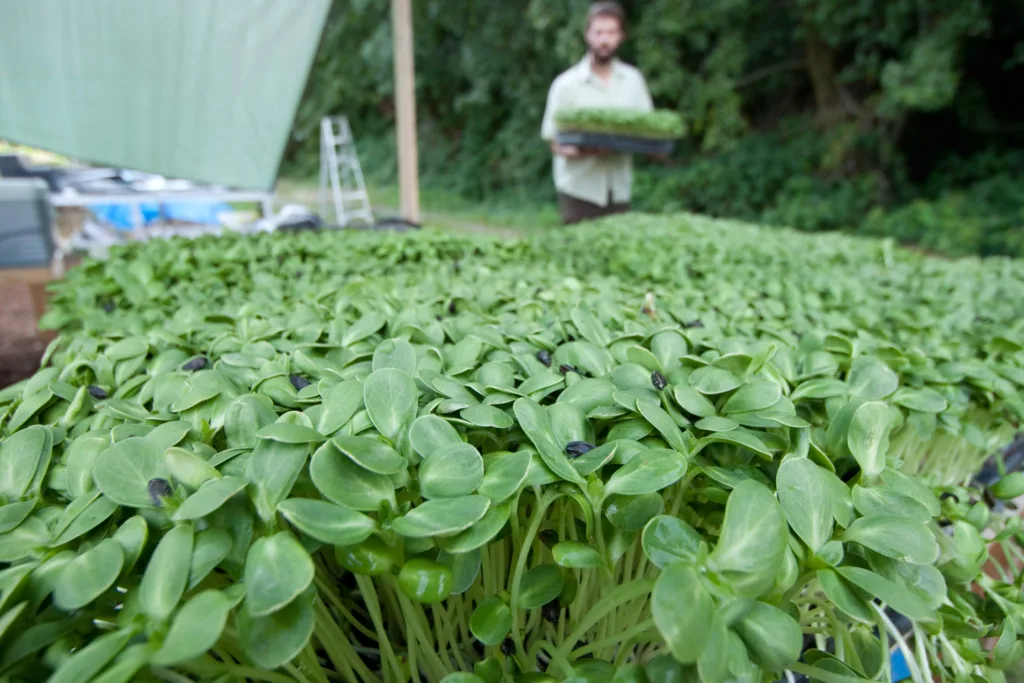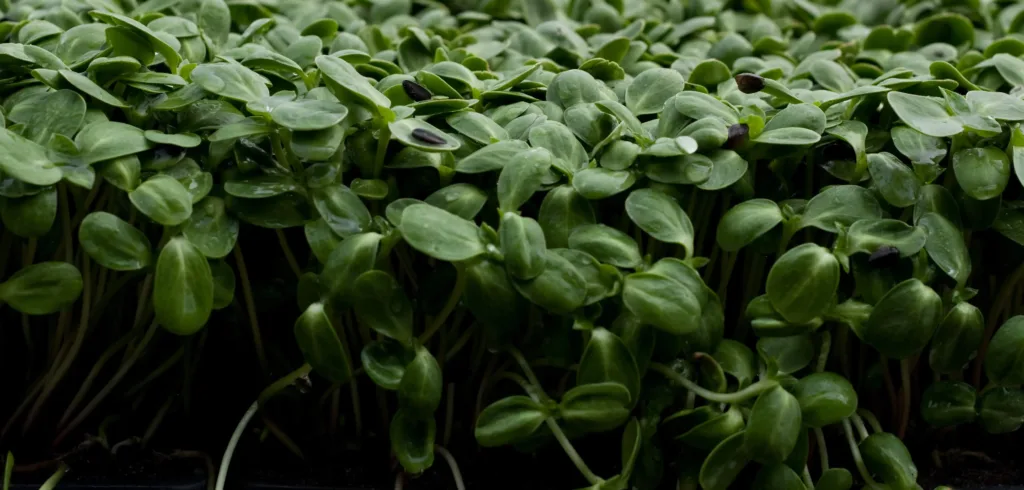
Is a Microgreens Business
Right For Me?
Introduction
Microgreens have exploded in popularity over the past decade, often touted as the perfect small business. High crop value, minimal space requirements, and fast turnaround times make them seem like a no-brainer for aspiring growers. But is that glossy surface hiding a less glamorous reality?
While the benefits are real, not everyone is cut out to run a microgreens business. Whether you’re looking to escape your 9-to-5, add to your farm’s revenue, or dip your toes into the food system with a home-based enterprise, it’s essential to ask: Is this really a fit for me?
This article will walk you through common motivations, hidden challenges, and key self-reflection questions that will help you determine if starting a microgreens business aligns with your skills, lifestyle, and goals.
The Dream vs. The Reality
Why Are So Many People Drawn to Microgreens?
At first glance, a microgreens business can look like the perfect venture. Here are the most common reasons people get excited:
1. A Desire for Change
Many people are looking to leave behind unsatisfying work and pursue something that feels meaningful. Microgreens seem like a simple, tangible entry into the sustainable food world.
2. Alignment with Personal Values
From health benefits to sustainable production, microgreens appeal to people who want to grow a product that matches their personal ethics.
3. Eye-Catching Numbers
It’s not hard to find stories of growers selling trays for $20–$50. Multiply that by 100 trays a week and you start to imagine a serious income from a small footprint.
4. Perception of Low Cost
Unlike many other farming operations, starting microgreens can seem inexpensive—especially if you’re planning to start at home.
5. Speedy “Seed to Cash”
Microgreens grow fast. Many crops are ready in 7 to 8 days, meaning quicker cash flow compared to field crops that can take months to mature.
But What Happens When the Honeymoon Ends?
The danger of a “perfect on paper” business is that it can cause tunnel vision. Once you’ve fallen in love with the idea, it’s easy to ignore red flags or convince yourself that you’ll figure it out later. But reality has a way of showing up fast.
This article is about balancing optimism with honesty. Because sometimes, not starting is the wisest move you can make.
Six Major Reasons Why a Microgreens Business Might Not Be Right for You
Let’s jump right into it and explore the most common reasons growers walk away from microgreens—sometimes before they even start, and sometimes after sinking in months of time and money.
1. Your Home Is Not a Farm
Many new growers want to start their microgreens business at home. It makes sense—you’re already paying rent or a mortgage, and home-based businesses are common. But food production, especially when done professionally, changes the equation.
Microgreens seems like they would be easy to integrate into your home, but they do come with some challenges:
- They can overwhelm your living space with trays, compost, soil, and racks.
- This means your home can often feel more like a workplace. You may be OK with that – but what about others in your family?
- Microgreens can greatly increase humidity in your home, leading to mold or permanent damage.
- As a food crop, microgreens introduce regulatory challenges, as most homes are not “approved” food-production spaces.
- And they can cause strain on personal relationships as your living room turns into a grow room.
Reality check: Your home is a fine place to prototype and learn. But if your long-term business plan relies on growing at home, you’re setting yourself up for frustration, conflict, and potential regulatory issues.
2. You’re Not Wired for Precision and Cleanliness
Growing microgreens is not like growing tomatoes in your backyard. You are essentially creating a mini food lab, where conditions must be controlled and cleanliness must be prioritized.
Professional growers need to:
- Sanitize trays, tools, and surfaces rigorously.
- Monitor and manage temperature, airflow, lighting, and humidity.
- Track variables like seeding density, water application, and crop timing.
- Understand and implement food safety best practices.
If you’re someone who avoids routines or bristles at rules, this might not be the right path. Precision is not optional—it’s foundational.
3. You Don’t Enjoy Repetitive Tasks
Seeding, watering, washing trays, harvesting. Then doing it again. And again. And again. Microgreens are a short-cycle crop, which means constant repetition.
In the early stages, you’ll likely do almost every work task by yourself. And even when the business grows, many tasks—especially washing and prepping trays—don’t go away.
If you dislike doing the same thing repeatedly or tend to rush through monotonous work, this will become a major source of burnout.
Tip: Repetitive work is easier to handle when you believe in the mission. If you’re not deeply motivated, it will start to wear you down fast.
4. You’re Not That Into Selling
Microgreens aren’t just a crop—they’re a product. And that means you have to sell it.
Professional growers spend a good chunk of time on:
- Sales calls and follow-ups with chefs and retailers.
- Farmers markets, product sampling, and customer engagement.
- Invoicing, payment collection, and customer service.
If you’re not comfortable interacting with people or dislike the idea of “selling,” you’ll struggle with this business. The product doesn’t sell itself—you do.
5. You’re Not Ready to Be a Manager
At some point, if your business grows, you’ll hit a labor ceiling. You can only seed, water, and deliver so many trays yourself.
To scale, you’ll need to:
- Hire and train staff.
- Manage schedules and team dynamics.
- Delegate tasks and trust others with critical parts of the operation.
If your dream is to “work alone and be your own boss,” this may conflict with the reality of what it takes to build a sustainable, income-generating operation.
6. You Can’t Sell Enough to Make It Work
Let’s get practical. For many aspiring growers, the numbers simply don’t add up.
To earn a $60,000/year salary, you may need to generate $125,000–$150,000 in annual sales. That could mean:
- Growing and selling 120–200 trays per week.
- Delivering to 20+ chefs or several retail accounts.
- Weekly markets are great for sales, but take a lot of time and effort
- Managing a tight, nonstop production schedule.
Do you have the infrastructure and market for that volume? Do you live in a city with enough high-end restaurants and consumers willing to pay premium prices?
If the answer is no, you might not be able to sell enough to make the business viable.
Context Matters: Special Situations to Consider
Are You a Market Gardener Thinking About Microgreens?
Adding microgreens to an existing farm might sound logical. But before you do:
- Do you have a separate, food-safe production and wash space?
- Do you have reliable labor to maintain the crop’s tight turnaround?
- Are you already maxed out during the growing season?
Microgreens require a different workflow than field crops. If you’re not prepared, they’ll disrupt more than they’ll support.
Are You an Activist or Homesteader?
If your draw to microgreens is rooted in food justice, sustainability, or homesteading values, consider this:
- Commercial food production often means conforming to regulations.
- You’ll need to work with (not against) systems of accountability.
- Your love of freedom might be challenged by food safety discipline.
This isn’t a critique—it’s a reflection point. Some people find that selling food professionally compromises the spirit that brought them to food in the first place.
When Microgreens Are a Good Fit
Let’s flip the script. If these scenarios apply to you, a microgreens business might be worth pursuing.
You Want to Prototype a Business
- You’re curious, not desperate for income.
- You want to build systems and skills with a manageable risk.
- You’re growing for yourself, your family, and a few friends or chefs.
You’re Adding to a Working Farm
- You already have customers asking for greens.
- You have a clean space to grow and process.
- You’re expanding your CSA or offering products at a farmers market.
You Have or Want a Team
- You’re entrepreneurial and eager to hire or partner.
- You enjoy delegation, training, and management.
- You’re building something bigger than yourself.
A Better Way to Make the Decision
Before you order seeds and build a rack:
Run the numbers.
Use a crop planning spreadsheet to forecast labor hours, expenses, sales goals, and profitability. This removes the guesswork.
Take a course or attend a workshop.
Learning from someone who’s done it can save you months (or years) of trial and error. There is lots of good free info online and a paid course can give you much more detail and a structured look at how to run a successful microgreens business.
Test yourself.
Can you consistently grow and sell 20 trays a week for two months? If not, scale up will only make it harder.
Talk to your household.
How does your family or partner feel about this? If they’re not on board, it’s a dealbreaker—especially in a home-based setup.
Final Thoughts
So—is a microgreens business right for you? It depends.
If you love detail, thrive on structure, enjoy repetitive tasks, and have the motivation to grow a business from scratch, then yes, microgreens can be a highly rewarding path.
But if you’re looking for a quick win, hate routine, or expect to make a full-time living with part-time effort, this might not be your crop.
There’s no shame in saying “not for me.” The only shame would be jumping in blind and regretting it later.
Resources for Smarter Decisions
Make informed decisions. Be realistic. And build something sustainable.

Leave a Reply